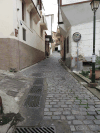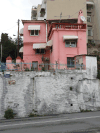
View over Kavala. (1215k)
From the Kavala entry in Wikipedia:
The city was founded in the late 7th century BCE by settlers from Thassos. It was one of several Thassian colonies along the coastline, all founded in order to take advantage of rich gold and silver mines, especially those located in the nearby Pangaion mountain (which were eventually exploited by Phillip II of Macedonia).
Worship of Parthenos/Virgin, a female deity of Greek Ionian origin associated with Athena, is archaeologically attested in the Archaic period. At the end of the 6th century BCE Neapolis claimed independence from Thassos and began issuing its own silver coins with the head of Gorgo (γοργὀνειο) on one side. A few decades later a large Ionic temple made from Thassian marble replaced the Archaic one. Parts of it can now be seen in the town's archaeological museum.
In 411 BCE, during the Peloponnesian War, Neapolis was besieged by the allied armies of the Spartans and the Thassians but remained faithful to Athens. Two Athenian honorary decrees in 410 and 407 BCE rewarded Neapolis for its loyalty.
Neapolis was a town of Macedonia, located 14 km (9 miles) from the harbor of Philippi. It was a member of the Second Athenian League; a pillar found in Athens mentions the contribution of Neapolis to the alliance. The town was later conquered by the Kingdom of Macedonia.
The military Roman road Via Egnatia passed through the city and helped commerce to flourish. It became a Roman civitas in 168 BCE, and was a base for Brutus and Cassius in 42 BCE, before their defeat in the Battle of Philippi.
The Apostle Paul landed at Neapolis during his first voyage to Europe.
In the 6th century, Byzantine emperor Justinian I, an Illyrian from Taor, Dardania (Procopius), fortified the city in an effort to protect it from barbarian raids. In later Byzantine times the city was called "Christo(u)polis" (Χριστούπολις, "city of Christ") and belonged initially to the theme of Macedonia and later to the Theme of Strymon. The first surviving mention of the new name is in a taktikon of the early 9th century. The city is also mentioned in the "Life of St. Gregory of Dekapolis". In the 8th and 9th centuries, Bulgarian attacks forced the Byzantines to reorganize the defense of the area, giving great care to Christoupolis with fortifications and a notable garrison. The city remained under Byzantine control and in 837 Byzantine armed forces from Christoupolis under the command of Caesar Alexius Moselie stopped Bulgarian raids in the plain of Philippoi.
At about 830-840 CE dates a Greek inscription on the walls of a defensive tower of the fortifications of the city, still visible today, and in 926, according to another inscription (nowadays in the archaeological museum of Kavala), the General of the Theme of Strymon Vasilios Klaudon, restored the "fallen and damaged" defensive walls.
In the mid of the 12th century the Arab geographer Edrisi visited Christoupolis and described it as a well fortified city and a center of sea trade. According to another inscription, also nowadays in the archaeological museum of Kavala, the Normans probably burnt the city in 1185, after they captured first Thessaloniki. Some years later, the city fell to the hands of the Lombards, after the Fourth Crusade and was liberated again by the leader of the state of Epirus, Theodorus Komnenos, in 1225.
In 1302, the Catalans failed to capture the city. In order to prevent them from coming back, the Byzantine emperor Andronikos III Palaiologos built a new long defensive wall. In 1357 two Byzantine officers and brothers, Alexios and John, controlled the city and its territory. Excavations have revealed the ruins of an early Byzantine basilica under an Ottoman mosque in the Old Town. It was used until the late Byzantine era.
The Ottoman Turks first captured the city in 1387. Kavala remained a part of the Ottoman Empire until 1912. In the 16th century, an Romanian that had converted to Islam in his late teen hood, Ibrahim Pasha, Grand Vizier of Suleiman the Magnificent, contributed to the town's prosperity and growth by reconstructing the late Roman (1st - 6th century CE) aqueduct. The Ottomans also extended the Byzantine fortress on the hill of Panagia. Both landmarks are among the most recognizable symbols of the city today.
All pictures are © Dr. Günther Eichhorn, unless otherwise noted.












This page contains 12 pictures
Here are the links to the other main pages on Greece:
Page last updated on Fri Jul 1 13:19:16 2022 (Mountain Standard Time)
Page last updated on Mon May 20 01:46:38 2024 (Mountain Standard Time)
Kavala on soaring.geichhorn.com